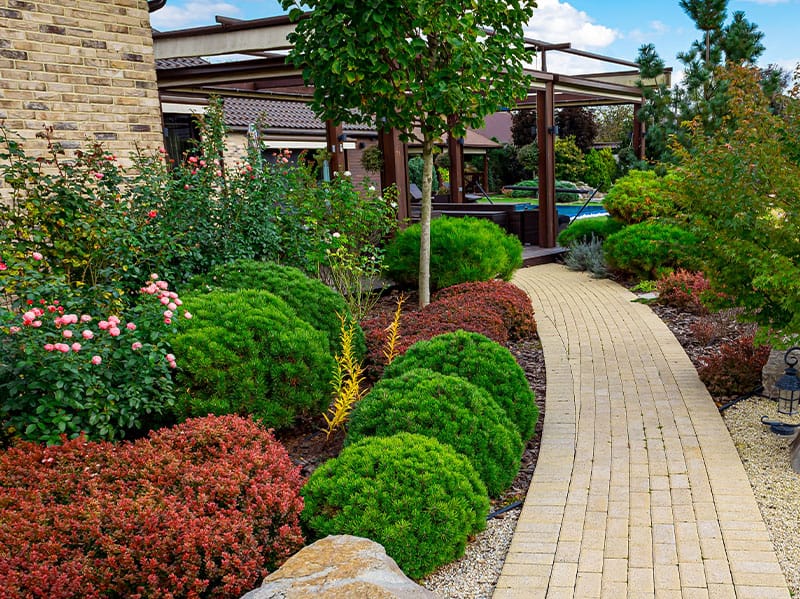8 Quick Tips for Tree and Shrub Care
In the yard, homeowners typically focus most of their attention on their lawn but forget that trees and shrubs need attention too. However, trees and shrubs in urban and suburban conditions are under more stress than trees and shrubs in their natural environments where nutrients are readily available. In a forest, fallen leaves and twigs naturally decompose, creating nutrient-rich soil without the competition of turfgrasses, plus the shade and spongy soil provide ample moisture. We compiled a list of down and dirty maintenance tips to help you replace the missing ingredients neighborhood environments lack to keep your landscape plants looking beautiful and healthy.

Healthy soil
Is your soil nutrient-rich? Soil is comprised of many components essential to plants. Not all soils are equal. What works for azalea shrubs won't necessarily work for your crape myrtle trees. Each specimen thrives in different soil. Does your soil hold moisture or shed moisture? Is your soil too acidic? What are the strengths and weaknesses of the soil in your landscape? The only way to truly know is by conducting a soil test. Soil tests provide answers to these questions and much more so you can make adjustments perfect for growing healthy plants. Need a soil test or analysis? Remove the guesswork. Call Nutri-Green today and sign up for our comprehensive soil testing service.
Shrub and tree pruning
Trimming away overgrowth and maintaining your ornamentals' shape is aesthetically pleasing and keeps nutrients supplied to crucial elements like flowering buds and significant branches and trunks. Most plants benefit from increased air circulation and the removal of dead or diseased branches.
Lawn and Tree Fertilization
Fertilization helps trees and shrubs stay healthy and vigorous. Fertilizer replenishes expended and used nutrients. It supplies food to keep plants and trees healthy and fight off disease and pests. Choose carefully and pick a fertilizer blended for the trees and shrubs in your landscape.
Insect and disease control
Healthy shrubs and trees naturally fight off pests and disease. The healthier the plant, the less likely you will have pests and disease. However, healthy plants are not bulletproof. Watch out for discoloration in the foliage, spots, or holes on the leaves. If you find issues, contact us, and our lawn care technicians will be happy to outline a plan for you.
Healthy mulch
The importance of mulch cannot be overstated. Mulch recreates the natural forest floor shrubs and trees are accustomed to that's covered by leaves and other organic matter, not by grass. It shades and cools the soil, adds nutrients, helps keep grass and weeds from growing, retains vital moisture, and insulated the roots during winter. Maintain at least a three-inch-thick-layer of fresh mulch yearly.
Efficient watering schedule
The same watering rule of thumb for grass applies to trees and shrubs. Water deeply, give a good soaking weekly rather than shallow, frequent watering. Some plants prefer heavy water, while others require less. Knowing your landscape watering needs can help prevent the drowning of some plants and reduce disease. Avoid water loss to evaporation by watering early morning before sunrise.
Weed control and prevention
Controlling weeds in the landscape can be difficult, but it is a critical maintenance practice. Weeds steal water and nutrients from shrubs and trees. Perennial weeds return year after year, have extensive root systems, and are more challenging to control than annual weeds. Remove weeds by hand-pulling. You can also keep a thick layer of mulch and use landscape fabric to deter weed growth. Nutri-Green can also help. We offer a 4-step treatment plan safe around your landscape plants that will knock out weeds and significantly reduce them from popping up. Call us today and stop weeds from invading your landscape beds.
Shrub stabilization
Stabilizing ornamentals can be beneficial when the trunk needs protection or support from factors like strong Oklahoma winds. Temporary stabilization can be helpful to hold large blooms upright. A tree should only be staked no more than one growing season, so it doesn't become overly dependent on the added support. Some trees require staking throughout their life. Remember to stabilize only if necessary and for a short period.
Here at Nutri-Green, we want you to enjoy the beauty of your landscape as much as we do. If you would like more tips for a healthy landscape or need our services, please give us a call. Our lawn care technicians are always here for you. All of this hard work cannot go without reward. Don't forget to enjoy the blooms or shade in your landscape. Bring in some freshly cut flowers from your hydrangeas or azaleas to perk up your day. Happy landscaping!







